So many different types of Agate, it can be difficult to identify them correctly and even harder to value them. Some of these varieties are hard to find because the available material is limited due to the mined areas running out of Agate.
If you’re looking to add Agate to your collection then I would start with the varieties listed below because they’re somewhat affordable, they look amazing, can be used in jewelry, and will retain their value.
Make sure to click the links provided below if you want a more detailed description of the Agate you’re interested in. These links will take you to additional pages with information pertaining to ‘how to identify”, “how to value”, and other frequently asked questions.
If you still can’t find the answer to your questions then feel free to join my newsletter “Pick & Shovel”. You’ll get free and unlimited access to me and I’ll do my best to ID your stones and answer your questions.
Different Types of Agate
There are 150 types of Agate, but we’ve narrowed this list down to some of the most popular varieties. Before you start looking through the pics and descriptions you might want to ensure you have authentic Agate and the best way to do that is by identifying it correctly.

Condor
Condor Agates, similar to Plume Agates, display quite a spectrum of colors within one stone. However, Condors showcases banding in concentric fashions, with each band separated by a different hue, making a captivating display.
This Agate variety is highly sought after by collectors due to its vibrant colors and sharp banding. Most nodules display intense yellow and orange bands, but the stones can also be found in shades of pink, green, and blue.
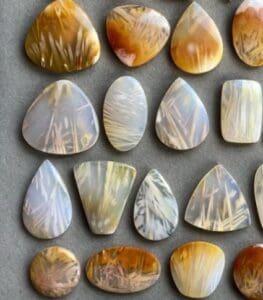
Sagenite
Sagenite Agates, or Sagenitic Agates, comprise any Agate with acicular or needle-like crystal growths or minerals that intersect in a grid or drill-like manner. The hair-like inclusions are usually displayed in fan or sunburst patterns, which is an excellent identifying quality.
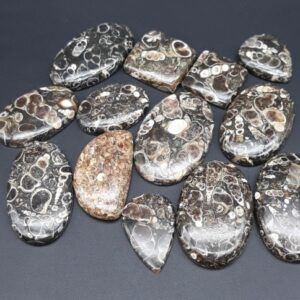
Turritella
Turritella Agates are found in the Green River Formation of Wyoming. A diversity of fossils are still found in this Formation today. Turritella is made up of shells from freshwater snails and a dark-colored Chalcedony.
This half-fossil, half-agate is prized among collectors, and lapidaries love working with these specimens. They’ve been collected and cut en cabochons within the lapidary community for over 50 years. Turritella Agate is excellent for jewelry!
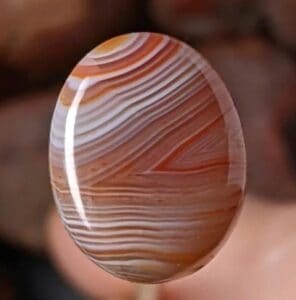
Lake Superior
Lake Superior Agates are beautiful and take an excellent polish. Nodules can be found along the shores of Lake Superior, hence the name.
One of the most significant differences between Lake Superiors and other Agates is the rich orange, red, and yellow colors caused by the oxidation of iron. The higher the iron concentration is, the deeper the color will be between the bands.
“Superior” Agates come in various sizes, but large nodules are a rare find.
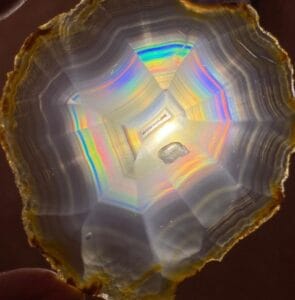
Iris
Iris (Rainbow) Agates are finely banded and produce a fantastic display of colors when cut into slabs of the correct thickness and illuminated from behind. Light travels through the bands, and dispersion causes the rainbow effect.
Iris Agates aren’t incredibly common at mineral and rock shows, but they can be found elsewhere. While this gemstone looks rare, it’s actually relatively common. You might discover specimens with private collectors or on various online sources; Etsy, gem and mineral sellers, jewelry stores, and Instagram are a few areas to search.
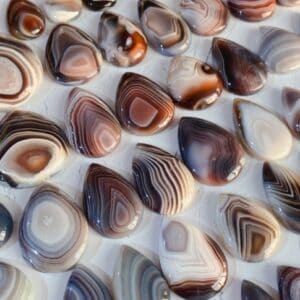
Botswana
Botswana Agates are formed by repeated floods of slow-moving lava laying down successive Quartz or Silica layers. This lava flow laid the foundation for large quantities of materials found in Botswana.
Botswana is generally an Agate variety found at many rock and mineral shows. However, if you’re trying to cut this variety into cabochons then you’ll want to be selective on how and where the banding is in the specimen. Keep your eye out for tight bands, clean colors, and orientation.

Crazy Lace
Crazy Lace Agates are incredibly beautiful. They exhibit lace-like patterns, like swirls, cat’s eyes, zigzags, and bands. Crazy Lace is banded Chalcedony or microcrystalline Quartz infused with iron and aluminum. Specimens often display bright colors and complex patterns. Together, the combination produces creamy browns, blacks, grays, and gold all swirled together. Occasionally, we might find a touch of pink or red as well.
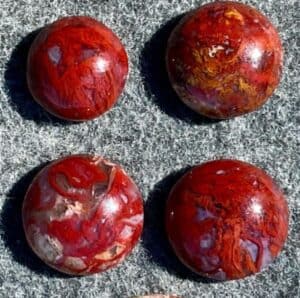
Plume
Plume Agates are relatively common and are mined from several locations in the US. Plumes differ from Dendritic Agate, which is generally more thin or branch-like. When Plume Agates are compared to Mossy Agate, the patterns are different, which is one way to identify these stones.
While many people think Plume Agates are rare, which is expected, this variety isn’t as rare as one might assume. The rarity lies more in the locality it was sourced. For instance, the specimen might have been mined in an area that is no longer open, or it’s not producing material. Some Plume Agate slabs or rough samples won’t be as readily available in that case.
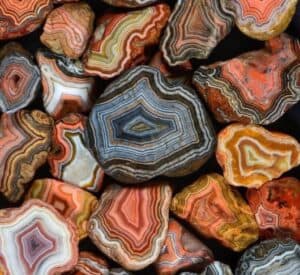
Fairburn
Fairburn Agates are a variety of Prarie Agates with scalloped fortifications. You’ll find that all information beyond that is a battle of semantics better met for those in academics. Fairburn is the simple, descriptive name for anyone who isn’t observing the thin strips of material under high-end microscopes.
This Agate variety is the official rock of South Dakota and is recognizable by the tight bands and bright colors: orange, red, yellow, blue, brown, white, and black.
Types of Agate Crystal
I did my best to provide popular varieties of Agate and I’ll continue to update this list when I find new varieties of Agate. If you want to see more and learn more about these varieties then I highly recommend you attend the upcoming Tucson Gem and Mineral Show. You won’t be able to find a better show with every variety of Agate known to man.
- Identify Enstatite - March 12, 2024
- Identify Cerussite - March 3, 2024
- Identify Bytownite - February 18, 2024

3 Responses
Thank you so much for putting this on here. I ha e been interested in rocks for a long time but I have only been able to get bits and pieces that explain much about them. I appreciate the way you explained these different types of agates. I can’t afford to travel different places to experience finding or seeing the different rocks. Susan Magby
Susan – Thanks for the kind words!!!
What a great article. Your pictures and descriptions, along with locations was really interesting. I feel like I have a much better understanding of identifying agates now – thank you!